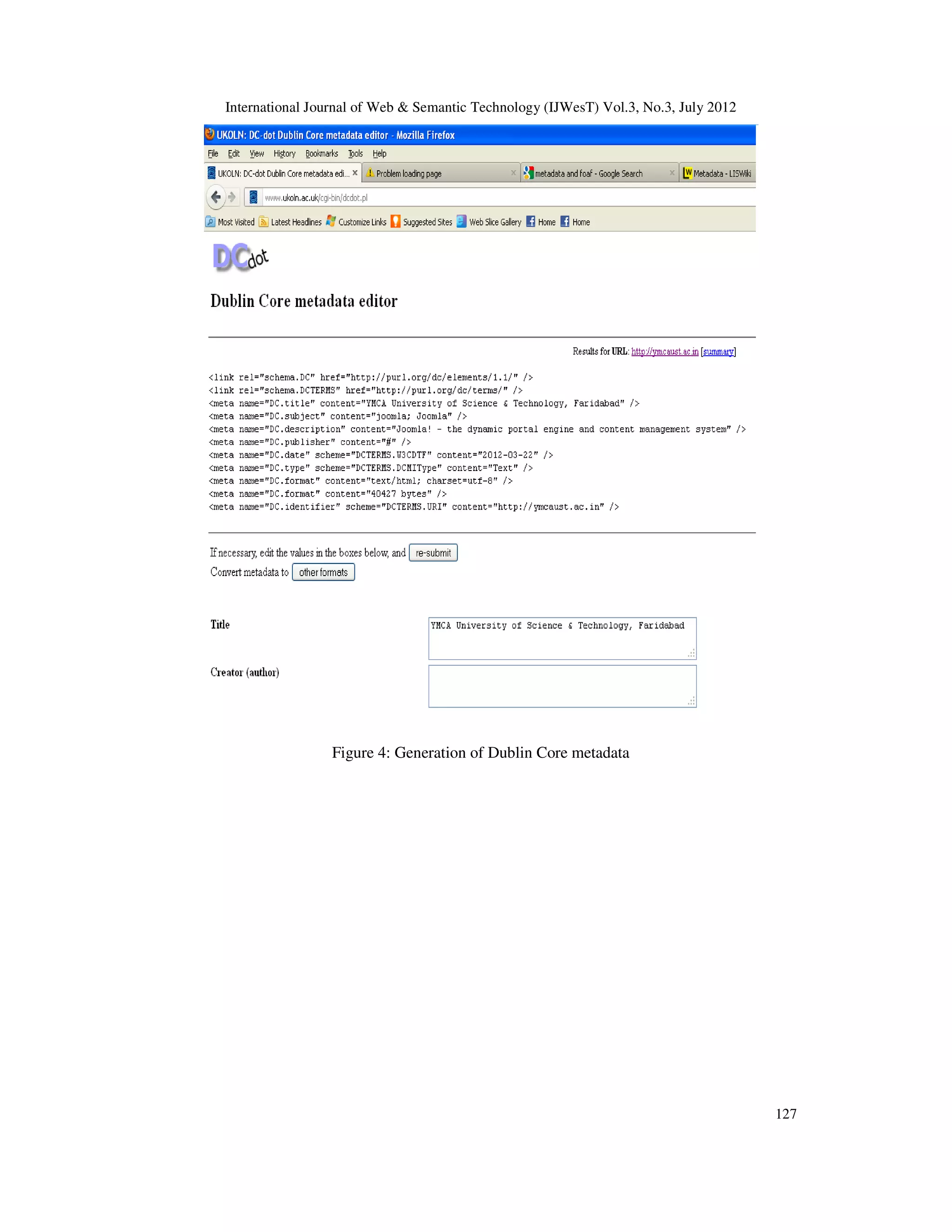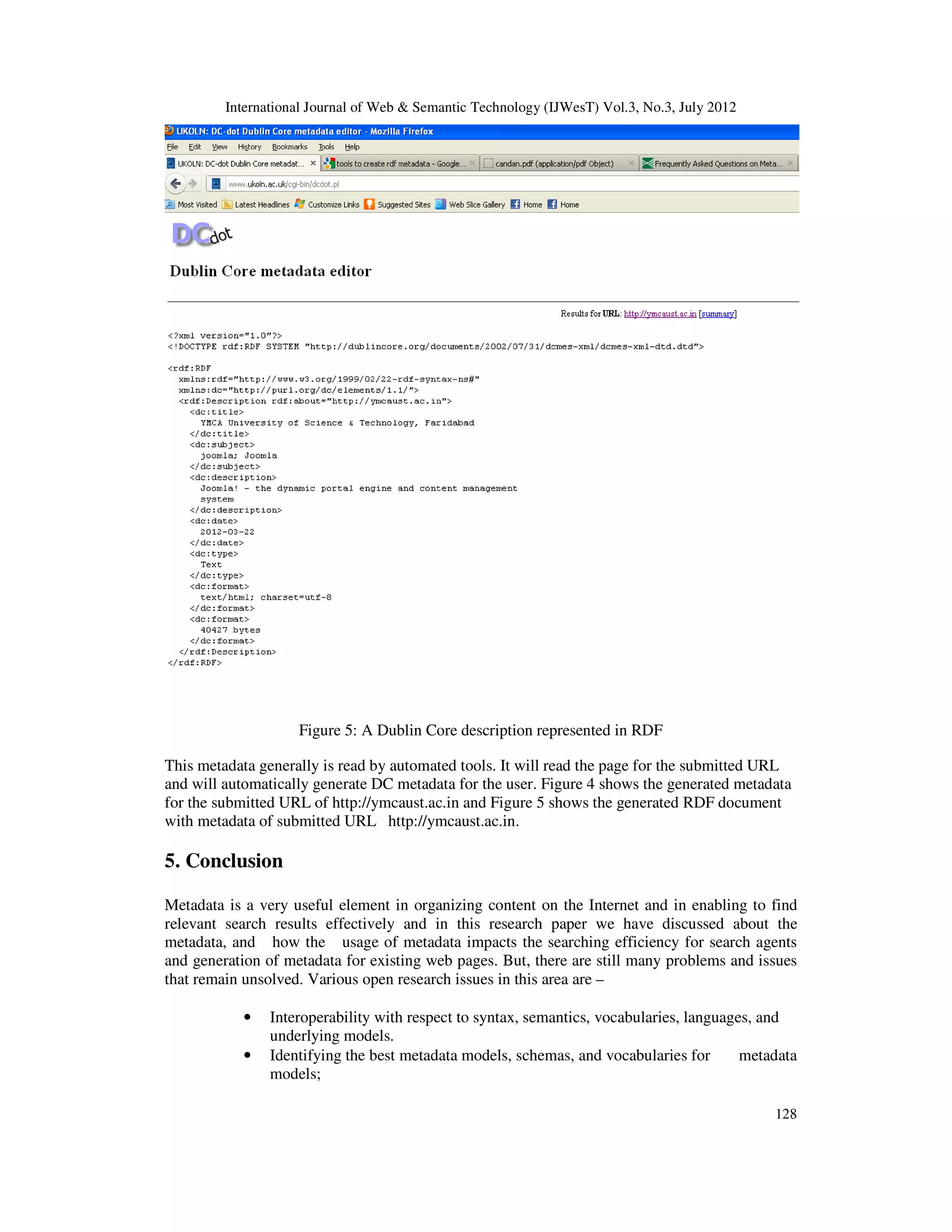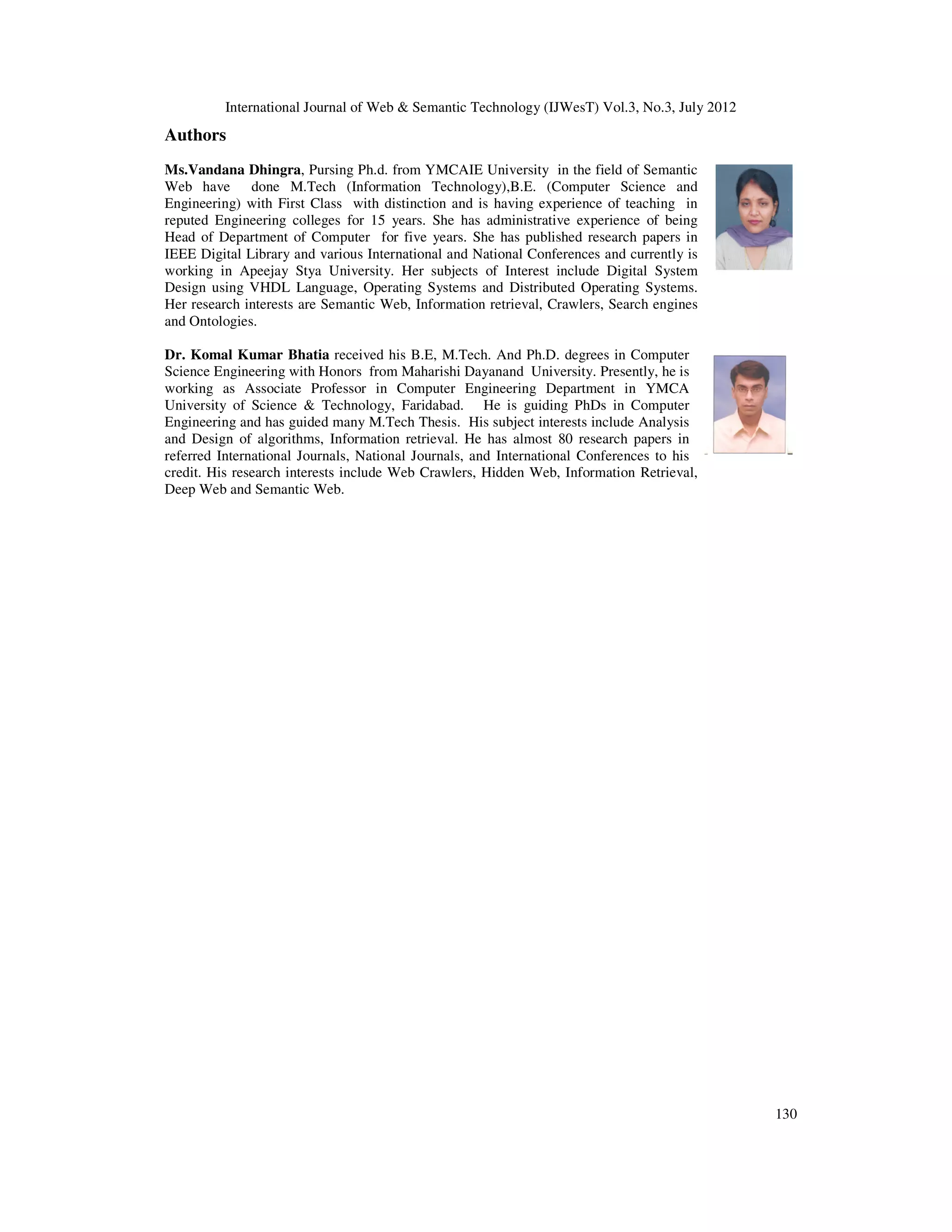The document discusses the importance of metadata in enhancing information retrieval on the web, highlighting its role in structuring and describing web resources to improve search precision and relevance. It outlines various types of metadata, schemas like Dublin Core, and tools for generating metadata for web pages, emphasizing the need for standardization and interoperability. The paper also addresses ongoing challenges in metadata practices and the potential of the semantic web to facilitate more intelligent retrieval methods.
![International Journal of Web & Semantic Technology (IJWesT) Vol.3, No.3, July 2012
DOI : 10.5121/ijwest.2012.3308 121
METADATA: TOWARDS MACHINE-ENABLED
INTELLIGENCE
Vandana Dhingra 1
and Komal Kumar Bhatia 2
1
School of Computational Sciences, Apeejay Stya University, Gurgaon, India
vandana.dhingra@asu.apeejay.edu
2
Department of Computer Science, YMCA University, Faridabad, India
komal_bhatia1@rediffmail.com
ABSTRACT
World Wide Web has revolutionized the means of data availability, but with its current structure model , it
is becoming increasingly difficult to retrieve relevant information, with reasonable precision and recall,
using the major search engines. However, with use of metadata, combined with the use of improved
searching techniques, helps to enhance relevant information retrieval .The design of structured,
descriptions of Web resources enables greater search precision and a more accurate relevance ranking of
retrieved information .One such efforts towards standardization is , Dublin Core standard, which has been
developed as Metadata Standard and also other standards which enhances retrieval of a wide range of
information resources. This paper discuses the importance of metadata, various metadata schemas and
elements, and the need of standardization of Metadata. This paper further discusses how the metadata can
be generated using various tools which assist intelligent agents for efficient retrieval.
KEYWORDS
Semantic web, Intelligent retrieval, FOAF, RDF, Metadata Schema & Dublin Core
1. INTRODUCTION
Metadata, in general terms is defined as “data about data” or information about information, it is
data that describes information resources. Metadata is structured information that describes,
locates and makes it easier to retrieve, use, or manage an information resource. The purpose of
metadata is ‘to facilitate search, evaluation, acquisition, and use’ of resources [1]. It is basically
structured data that allows machine readability and understandability, which is basically the
vision for Semantic Web.
Metadata can be used to add information that can be used to describe the document such as:
• Title of document
• Author of document
• Time and date of creation
• Standards used
•
There are three main types of metadata [2]:
1Descriptive metadata describes a resource for purposes such as discovery and identification. It
can include elements such as title, abstract, author, and keywords.](https://image.slidesharecdn.com/3312ijwest08-221104035529-2f3b2d36/75/Metadata-Towards-Machine-Enabled-Intelligence-1-2048.jpg)
![International Journal of Web & Semantic Technology (IJWesT) Vol.3, No.3, July 2012
122
2. Structural metadata indicates how compound objects are put together, for example, how pages
are ordered to form chapters.
3. Administrative metadata provides information to help manage a resource, such as when and
how it was created, file type and other technical information, and who can access it. There are
several subsets of administrative data; two that sometimes are listed as separate metadata types
are:
a. Rights management metadata, which deals with intellectual property rights, and
b. Preservation metadata, which contains information needed to archive and preserve a
resource.
Metadata descriptions present two advantages [3]:
• They enable the abstraction of details such as the format and organization of data, and capture
the information content of the underlying data independent of representational details. This
represents the first step in reduction of information overload, as intentional metadata descriptions
are in general an order of magnitude smaller than the underlying data.
• They enable representation of domain knowledge describing the information domain to which
the underlying data belong. This knowledge may then be used to make inferences about the
underlying data. This helps in reducing information overload as the inferences may be used to
determine the relevance of the underlying data without accessing the data.
The remainder of this paper is organized as follows: In section 2 we have given an overview of
metadata schemas and element sets .Section 3 describes the structuring of metadata, including
Dublin Core standard .Section 4 describes about the role of metadata in Semantic web. Section 5
covers how we can generate metadata for the existing web pages with the related work and
Section 6 concludes the paper.
2. Metadata Schemas and Element Sets
2.1. Metadata Schema
A schema is a set of rules covering the elements and requirements for coding. Metadata schemas
are sets of metadata elements designed for a specific purpose, such as describing a particular type
of information resource. The definition or meaning of the elements themselves is known as the
semantics of the schema.
Some of the most popular metadata schemas include:
Dublin Core
AACR2 (Anglo-American Cataloguing Rules)
GILS (Government Information Locator Service)
EAD (Encoded Archives Description)
IMS (IMS Global Learning Consortium)
AGLS (Australian Government Locator Service)
Examples of schemas in the semantic web include Dublin Core, FOAF (Friend of a Friend), and
many others. Metadata schemas specify names of elements and their semantics. Many current
metadata encoding schemes are:](https://image.slidesharecdn.com/3312ijwest08-221104035529-2f3b2d36/75/Metadata-Towards-Machine-Enabled-Intelligence-2-2048.jpg)
![International Journal of Web & Semantic Technology (IJWesT) Vol.3, No.3, July 2012
123
• SGML (Standard Generalized Mark-up Language)
• XML (Extensible Mark-up Language).
• XML, developed by the World Wide Web Consortium (W3C.)
• HTML (Hyper-Text Markup Language)
2.2. Metadata Deployment
Metadata may be deployed in a number of ways:
• Embedding the metadata in the Web page using META tags in the HTML coding of the
page
• As a separate HTML document linked to the resource it describes
• In a database linked to the resource. The records may either have been directly created
within the database or extracted from another source, such as Web pages.
3. Structuring of Metadata
The metadata of each web document has its own structure, so there is need for some structure so
that this data can be processed by machines in uniform manner. Different author’s will have their
own ways to describe a given page, by this each page will have its own unique structure, and it
will not be possible for an automated agent to process this metadata in uniform way. So for
processing by machines, there is need for some metadata standard. Such kinds of standards are
called metadata schemas. Dublin Core is one such standard.
3.1 Dublin Core Standard
It has 13 elements which are called as Dublin Core metadata Element Set. Basic metadata
elements indicate the title, author, year of publication and similar simple bibliographic data.
Richer metadata structures also cover technical features, copyright properties, annotations and so
on[4].These original 13 core elements were later increased to 15[5]:
• Title: a name given to the resource
• Creator: an entity primarily responsible for making the resource
• Subject: the topic of the resource
• Description: an account of the resource
• Publisher: an entity responsible for making the resource available
• Contributor: an entity responsible for making contributions to the resource
• Date: a point or period of time associated with an event in the lifecycle of a resource
• Type: the nature or genre of the resource
• Format: the file format, physical medium, or dimensions of the resource
• Identifier: an unambiguous reference to the resource within a given context
• Source: the resource from which the described resource is derived
• Language: a language of the resource
• Relation: a related resource
• Coverage: the spatial or temporal topic of the resource, the spatial applicability of the
resource, or the jurisdiction under which the resource is relevant
• Rights: information about rights held in and over the resource
Figure 1 shows how DC metadata Standard can be used in html web page The Dublin Core
metatags can be placed within the head section of the HTML code of web pages. Normally, the
Dublin Core elements are preceded by the "DC" abbreviation. The best method to be used](https://image.slidesharecdn.com/3312ijwest08-221104035529-2f3b2d36/75/Metadata-Towards-Machine-Enabled-Intelligence-3-2048.jpg)
![International Journal of Web & Semantic Technology (IJWesT) Vol.3, No.3, July 2012
124
whenever you need to use Dublin Core elements in your HTML code is to have this metadata
embedded. The main characteristics of Dublin Core are:
• Simplicity (of creation and maintenance)
• Interoperability (among collections and indexing systems)
• International applicability
• Extensibility
• Modularity
Figure 1: Example of the Dublin Core Metadata Elements could be used in Web content
4. Role of Metadata in Semantic Web
Tim Berners-Lee introduced the term “Semantic Web” foreseeing the concept that we are creating
a web which can only be managed when we use intelligent software agents[6]. Tim Berners-Lee's
vision for Web is termed the "semantic Web," where semantic Meta data are the building blocks.
One such effort towards this is Semantic Search engine is Swoogle[7]. It is an implemented
metadata and search engine for online Semantic Web documents. Swoogle analyzes these
documents and their constituent parts (e.g., terms and triples) and records meaningful metadata
about them [8]. By annotating or enhancing documents with semantic metadata, software
programs (agents) can automatically understand the full context and meaning of each document
and can make correct decisions about who can use the documents and how these documents
should be used.It offers a set of rules for creating semantic relations and RDF Schema can be
used to define elements and vocabularies. The relations are defined with a very simple
mechanism that can also be processed by machines. In an RDF environment every resource has to
have a unique identifier (URI). It can have properties and properties can have values.
Users will not be able to process the huge amount of knowledge available on the web. Semantic
Web is based on the fundamental idea that web resources should be annotated with semantic
mark-up that captures information about their meaning[9]. The objective is to provide a common
framework that allows data to be shared and reused across applications, and which brings
structure to the meaningful content of WebPages which results in creating an environment where
software agents roaming from page to page readily carry out advanced searches. Hence, the
metadata initiatives are important steps towards the realization of the Semantic Web. Following
subsections describes various representation languages for describing metadata-
<html>
<head>
<title>Example Metadata in Dublin Core</Title>
<meta name="DC.Title" content="Example Metadata in Dublin Core">
<meta name="DC.Creator" content="Vandana Dhingra">
<meta name=" DC.Creator.Address" content="vandana@yahoo.com">
<meta name="DC.Date.Created" Content="2012-02-10">
<meta name="DC.Type" Content="Text.Homepage.Tutorial">
<meta name="DC.Format" Content="Text/Html">
</head>
<body>
This is my first tutorial in Dublin Core
</body>
</html>](https://image.slidesharecdn.com/3312ijwest08-221104035529-2f3b2d36/75/Metadata-Towards-Machine-Enabled-Intelligence-4-2048.jpg)
![International Journal of Web & Semantic Technology (IJWesT) Vol.3, No.3, July 2012
125
4.1 RDF/XML
RDF provides a rich foundation to describe metadata.RDF (Resource Description Framework)
allows multiple metadata schemes to be read by humans as well as parsed by machines. It uses
XML (EXtensible Markup Language) to express structure thereby allowing metadata
communities to define the actual semantics [10].RDF allows multiple objects to be described
without specifying the detail required. The underlying glue, XML, simply requires that all
namespaces be defined and once defined; they can be used to the extent needed by the provider of
the metadata.
The Resource Description Framework (RDF), developed by the World Wide Web Consortium
(W3C), is a data model for the description of resources on the Web that provides a mechanism for
integrating multiple metadata schemes. For metadata, the most popular bindings nowadays are
XML, or, more specifically, RDF [11].In RDF a namespace is defined by a URL pointing to a
Web resource that describes the metadata scheme that is used in the description. Multiple
namespaces can be defined, allowing elements from different schemes to be combined in a single
resource description. Multiple descriptions, created at different times for different purposes, can
also be linked to each other.
Example: Description with a single statement, which uses a language-tagged literal value.
“Vandana is the author of the resource”[12]
Figure 2: Metadata Represented in RDF document
The ontology creation language OIL extends RDF Schema and allows you to be much
more specific about what sort of thing a person is, the properties a thing needs to have to
be a wn:person and so on[13].
4.2 FOAF
It is one of the metadata standards for the Semantic Web, Figure 2 represents an example of Web
document represented in FOAF .FOAF is all about creating and using machine-readable
homepages that describe people, the links between them, and define things they create and do.
FOAF defines an RDF vocabulary for expressing metadata about people and the relation among
them.
Vandana Dhingra is the creator of the resource
http://vandana.dhingra/home/index.html
can be represented in RDF by
<? xml version="1.0"?>
<rdf: RDF
xmlns:rdf=" http://vandana.dhingra/2000/22 -rdf-syntax-
ns#"
xmlns:s="http://description.org/schema/">
<rdf: Description about="
http://vandana.dhingra/home/index.html ">
<s: Creator>vandana</s: Creator>
</rdf: Description>
</rdf: RDF>](https://image.slidesharecdn.com/3312ijwest08-221104035529-2f3b2d36/75/Metadata-Towards-Machine-Enabled-Intelligence-5-2048.jpg)
![International Journal of Web & Semantic Technology (IJWesT) Vol.3, No.3, July 2012
126
Figure 3: Metadata represented in FOAF
5. Generation of Metadata for Existing Web Pages
Metadata generation tools generate metadata from Web resources and store it in RDF for later
use. There are various metadata tools to create metadata for already existing Web pages. One
such tool for creating metadata is
1. Reggie[14]- is a tool capable of extracting metadata from given Web pages. The user can
select any existing schema file or can create his/her own schema files. Reggie extracts the META
tags from a given URL and attempts to add them to the most appropriate fields of the chosen
schema. It also allows users to create their own metadata schema files.
2. DC-DOT [15] is another tool for metadata extraction. In comparison to Reggie where the user
provides the schema file, DC-DOT specifically uses the Dublin Core schema, a metadata element
set for description of electronic resources, to extract metadata from a given Web resource. DC-
DOT uses the information contained in the META tags of a Web source to generate the RDF
model.
Using DC-dot
It will read the page you submit and automatically generate DC metadata for the web page.
rdf:Description>
<dc: title>Tutorial </dc: title>
<dc: creator>
<foaf:Person>
<foaf:name>Vandana Dhingra </foaf:name>
<foaf: homepage
rdf:resource="http://rdfweb.org/people/vandana "/>
</foaf: Person>
<dc: description>Semantic Web Tutorial](https://image.slidesharecdn.com/3312ijwest08-221104035529-2f3b2d36/75/Metadata-Towards-Machine-Enabled-Intelligence-6-2048.jpg)


![International Journal of Web & Semantic Technology (IJWesT) Vol.3, No.3, July 2012
129
• Ensuring authenticity, and integrity of the metadata by using various metadata
extraction tools
• How to design the repositories for storage and management of metadata.
• Lot of efforts is required in human-generated metadata, a large number of
research initiatives are required in focusing on technologies to enable the
automatic generation of metadata in various domains like text, imaging ,video.
REFERENCES
[1] IEEE 2001 Draft standard for Learning Object Metadata Draft 6.1, April 2001
http://ltsc.ieee.org/wg12/index.html
[2] N ISO. (2004) Understanding Metadata. Bethesda, MD: NISO Press, p.1
[3] Sheth, A” Changing Focus on Interoperability in Information Systems: from System, Syntax,
Structure to Semantics” Goodchild M.F., Egenhofer, M.J., Fegeas, R., Koffman, C.A. (eds.):
Interoperating Geographic Information Systems. Kluwer Academic Publishers, Boston (1999) 5-29
[4] Erick Duval Journal of Universal Computer Science, vol. 7, no. 7 (2001), 591-601 28/7/01 Springer
Pub. Co. Metadata Standards: What, Who, Why?
[5] Dublin Core Metadata Element Set, Version 1.1 Reference Description
http://purl.org/dc/documents/rec-dces-19990702.htm
[6] T. Berners-Lee, J. Hendler, and O. Lassila. The Semantic Web. Scientific American, May, 2001.
[7] Li Ding, et al., “Swoogle: A semantic web search and metadata engine,” Int. Proc. 13th ACM Conf.
on Information and Knowledge Management, Washington D.C., USA, Nov. 2004
[8] Li Ding, et al., “Search on the Semantic Web,” Department of Computer Science and Electrical
Engineering, University of Maryland Baltimore County, Baltimore, Tech. Rep. TR CS-05-09 , Sep.
2005
[9] Steffen Staab ,IEEE INTELLIGENT SYSTEMS Where Are the Rules? 1094-7167/03/$17.00 ©
2003 IEEE
[10] D. Brickley and R. Guha. Resource Description Framework (RDF) schema specification, 2000.
http://www.w3.org/TR/RDF-schema.
[11] W3C Document Metadata and resource Description, April 2001
<http://www.w3.org/Metadata/>.
[12] Vandana Dhingra,Komal Bhatia” Towards Intelligent Information Retrieval on Web” International
Journal on Computer Science and Engineering (IJCSE) ,Vol. 3 No. 4 Apr 2011
[13] Libby Miller “ Ontologies and Metadata “A Draft Discussion of issues raised by the Semantic Web
Technologies Workshop, 22-23 November 2000.
[14] Resource discovery unit of DSTC, Reggie the Metadata
Editor.http://metadata.net/dstc/SchemaFiles.html.
[15] Dublin Core Metadata Editor (DCDOT), 2000.
http://www.ukoln.ac.uk/metadata/dcdot
.](https://image.slidesharecdn.com/3312ijwest08-221104035529-2f3b2d36/75/Metadata-Towards-Machine-Enabled-Intelligence-9-2048.jpg)
